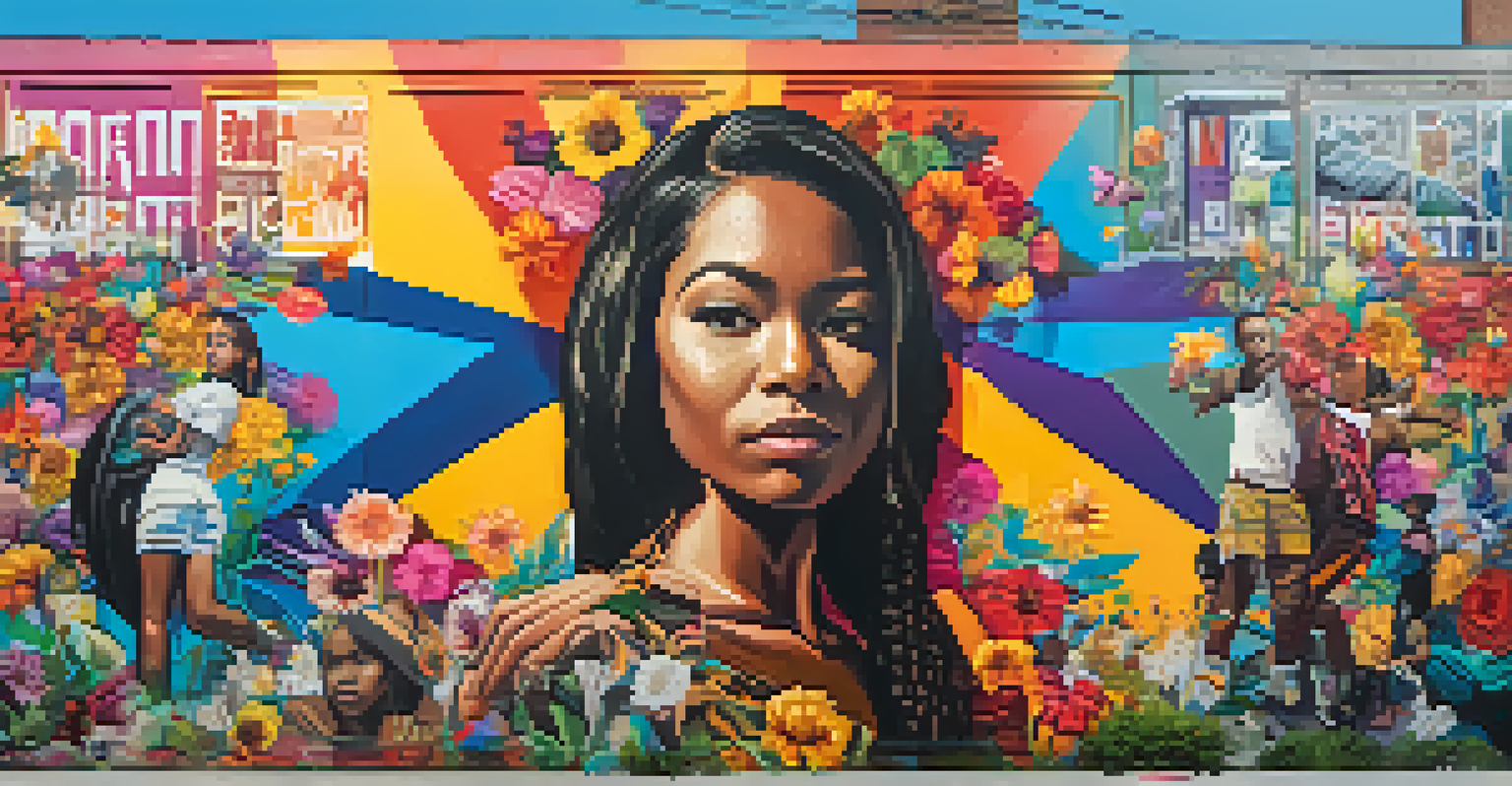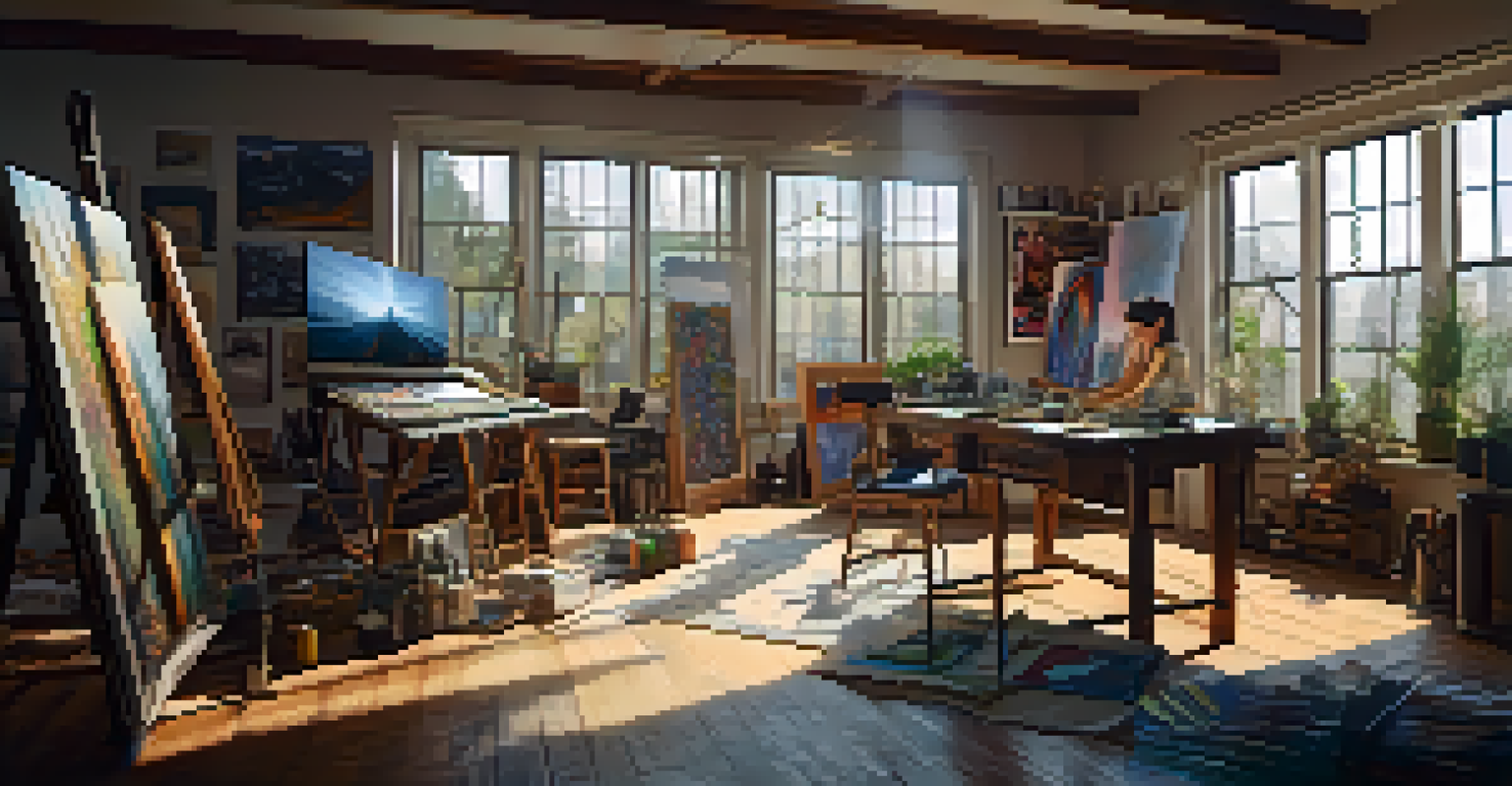The Relationship Between Art Movements and Cultural Dialogue

Understanding Art Movements and Their Cultural Roots
Art movements often emerge as reflections of the cultural and social climates of their time. For instance, the Impressionist movement in the late 19th century arose as a response to the rapid industrialization and urbanization in Europe. Artists sought to capture fleeting moments and the effects of light, mirroring the chaos and beauty of contemporary life.
Art is the most beautiful of all lies.
Cultural dialogue plays a crucial role in shaping these movements, as artists respond to the events and ideologies around them. Just as Impressionism reacted to modernity, the Harlem Renaissance celebrated African American culture and heritage, creating a powerful narrative of identity and resilience. This interplay highlights how art serves as a mirror to society’s evolving values.
By understanding the cultural roots of art movements, we can appreciate their significance beyond aesthetics. They provide insight into the collective consciousness of a society, offering a canvas that depicts struggles, triumphs, and the ongoing dialogue about identity and belonging.
Art Movements as Responses to Historical Events
Throughout history, significant events have catalyzed the emergence of various art movements. For example, the Dada movement originated during World War I as a reaction against the senselessness of war and the societal norms that led to it. Artists like Marcel Duchamp used absurdity and irony to challenge traditional notions of art, reflecting the disillusionment felt by many.

Similarly, the Surrealist movement, which followed Dada, delved into the subconscious mind and dreams, offering a way to process the trauma of war. Artists such as Salvador Dalí and André Breton explored themes of irrationality and the fantastical, providing a counter-narrative to the harsh realities of their time. This illustrates how art can act as both a commentary and a coping mechanism.
Art Reflects Cultural Context
Art movements emerge in response to the cultural and social climates of their time, serving as a mirror to society's evolving values.
These movements remind us that art is not created in a vacuum; it is deeply intertwined with historical context. By examining how art responds to events, we gain a deeper understanding of its power to provoke thought, inspire change, and foster dialogue about the human experience.
The Role of Cultural Exchange in Art Movements
Cultural exchange is a vital component in the development of art movements, as it allows for the blending of ideas and influences from different traditions. The Renaissance, for example, saw a revival of classical learning and the blending of European and Middle Eastern artistic practices, thanks to the trade routes established during that time. This cross-pollination of ideas led to groundbreaking advancements in techniques and themes.
Every artist dips his brush in his own soul, and paints his own nature into his pictures.
In contemporary art, globalization has further accelerated this exchange, enabling artists from diverse backgrounds to share their perspectives and techniques. The incorporation of elements from African, Asian, and Indigenous art into Western practices has enriched the global art scene, creating a vibrant tapestry of cultural dialogue. This interaction fosters empathy and understanding across cultures.
Ultimately, cultural exchange not only influences the aesthetic of art movements but also enhances the narratives they encapsulate. By embracing diverse influences, artists can create works that resonate on multiple levels, inviting audiences to engage in a broader conversation about identity, heritage, and shared human experiences.
Art as a Tool for Social Commentary
Art has long been utilized as a tool for social commentary, allowing artists to voice their perspectives on pressing issues. Movements like Social Realism in the early 20th century sought to highlight the struggles of the working class and the injustices of society through powerful imagery. Artists like Diego Rivera used their work to advocate for social change, showing how art can mobilize public sentiment.
Similarly, contemporary movements such as street art and feminist art challenge societal norms and provoke discussions around issues like gender equality and racial justice. Artists like Banksy use public spaces to make bold statements that reach wider audiences, effectively breaking down barriers between art and everyday life. This accessibility fosters a cultural dialogue that resonates with people from all walks of life.
Technology Shapes Artistic Expression
Advancements in technology, from the camera to digital platforms, have transformed the creation and dissemination of art, influencing contemporary movements.
This aspect of art reinforces its role as a catalyst for change, as it encourages viewers to reflect on their beliefs and the world around them. By sparking conversations around social issues, art has the potential to inspire action and foster a sense of community among those who engage with it.
The Impact of Technology on Art Movements
Technology has always played a significant role in shaping art movements, influencing both the creation and dissemination of art. The invention of the camera in the 19th century revolutionized how artists approached their work, leading to movements like Impressionism that focused on capturing light and movement rather than mere replication. This shift encouraged artists to explore new techniques and styles.
In today’s digital age, technology continues to transform the art landscape. Digital art, virtual reality, and social media platforms have opened up new avenues for artistic expression and connection. Artists can now reach global audiences, share their work instantaneously, and collaborate across borders, enriching the cultural dialogue in ways previously unimaginable.
As we move forward, the relationship between technology and art will only deepen, raising questions about authorship, authenticity, and the future of artistic practices. Understanding this dynamic allows us to appreciate how art movements evolve and adapt, reflecting the ever-changing cultural landscape.
The Influence of Political Movements on Art
Political movements have historically shaped art movements, as artists respond to the ideologies and policies of their time. The Russian Revolution, for example, led to the emergence of Constructivism, which aimed to create art that served the needs of the state and its citizens. Artists like El Lissitzky and Vladimir Tatlin sought to use their work as a means of promoting social change and collective progress.
In contrast, expressions of dissent can also be found in art, as seen in the political works of artists during the Civil Rights Movement in the U.S. Artists like Jacob Lawrence used their art to portray the struggles and resilience of African Americans, contributing to a broader dialogue on race and equality. This highlights how art can act as both a tool for empowerment and a means of protest.
Political Climate Influences Art
Political movements have historically shaped art, with artists responding to ideologies and societal issues, using their work as a tool for empowerment and protest.
By examining the interplay between art and political movements, we can better understand how cultural dialogues are shaped by the political climate. Art not only reflects societal values but also serves as a platform for challenging the status quo and advocating for change.
Looking Ahead: The Future of Art Movements and Cultural Dialogue
As we look to the future, the relationship between art movements and cultural dialogue will continue to evolve. Emerging global challenges, such as climate change and social inequality, are likely to inspire new movements that reflect the collective concerns of our time. Artists are increasingly using their platforms to engage with these issues, fostering awareness and dialogue through their work.
Moreover, the rise of technology will further influence how art is created, shared, and experienced. We can expect to see innovative mediums that blend physical and digital realms, fostering new forms of interaction and engagement. This evolution will open up opportunities for diverse voices to be heard, enriching the cultural dialogue.

Ultimately, the future of art movements lies in their ability to adapt and respond to the world around them. As artists continue to engage with cultural, social, and political issues, they will play a pivotal role in shaping conversations that matter, inviting audiences to join in the dialogue and reflect on our shared humanity.